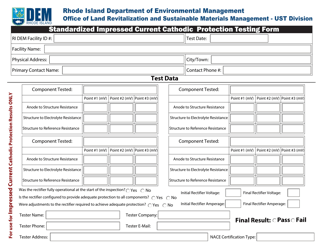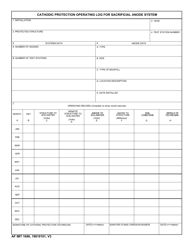Standardized Sacrificial Anode Cathodic Protection Testing Form - Rhode Island
Standardized Cathodic Protection Testing Form is a legal document that was released by the Rhode Island Department of Environmental Management - a government authority operating within Rhode Island.
FAQ
Q: What is a sacrificial anode?
A: A sacrificial anode is a metal rod or plate that is connected to a metal structure to protect it from corrosion.
Q: What is cathodic protection testing?
A: Cathodic protection testing is a procedure used to evaluate the effectiveness of a sacrificial anode system in protecting metal structures from corrosion.
Q: Why is sacrificial anode cathodic protection important?
A: Sacrificial anode cathodic protection is important because it helps prevent corrosion of metal structures, which can prolong their lifespan and reduce repair or replacement costs.
Q: What is the purpose of the standardized testing form?
A: The purpose of the standardized testing form is to provide a consistent and organized approach to evaluate the performance of sacrificial anode cathodic protection systems.
Q: Is the standardized testing form specific to Rhode Island?
A: Yes, the standardized testing form mentioned is specific to Rhode Island. It may not be applicable or recognized in other states.
Q: Who typically performs the cathodic protection testing?
A: Cathodic protection testing is usually performed by qualified technicians or engineers who specialize in corrosion control.
Q: What happens if a sacrificial anode system is found to be ineffective?
A: If a sacrificial anode system is found to be ineffective, it may need to be repaired or replaced to ensure proper corrosion protection for the metal structure.
Q: Are there any regulations or standards related to sacrificial anode cathodic protection?
A: Yes, there are industry standards and regulations, such as NACE International standards, that provide guidelines for the design, installation, and testing of sacrificial anode cathodic protection systems.
Form Details:
- The latest edition currently provided by the Rhode Island Department of Environmental Management;
- Ready to use and print;
- Easy to customize;
- Compatible with most PDF-viewing applications;
- Fill out the form in our online filing application.
Download a fillable version of the form by clicking the link below or browse more documents and templates provided by the Rhode Island Department of Environmental Management.



